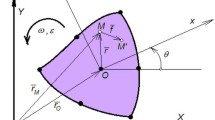Abstract
The article deals with the problems of controllability, observability and stabilizability of an elastic-structural system treated by the finite element method. The results obtained here agree with that obtained in distributed parameter-system model, nevertheless, they are more convenient than those in carrying out the computation with a computer, at the same time the method appears much easier that the conventional one. In section one, the system's controllability and observability are studied and some conditions which are easier to be justified by computer are given. In section two, the problem of stabilizing an elastic object by the use of linear feedback is fully discussed. As the attained results there show that, so far as an elastic-structural system is concerned, it is possible to assign arbitrary frequencies of vibration only by the use of displacement feedback, however, it is impossible to stabilize the system while the system is completely controllable. While the velocity feedback can stabilize the system, but its ability is limited. The case of rigid body motion involved in the system equation has also been discussed. In section three, the control of a straight beam is treated by the finite element method. The whole system of a beam can be decomposed into four irrelevant subsystems of tension-compression, torsion, bending in two directions, their controllability and observability are also analyzed respectively. The controllability and observability of segment-shaped beam are discussed in the end.
Similar content being viewed by others
References
Kwan Chao-chih et Wang Kang-ning, Sur la stabilisation de la vibration e'lastique. (I) Scientia Sinica, Vol. 17, pp. 446–467. (1974).
Wang Kang-ning, Sur la stabilisation de la vibration e'lastique (II). Acta Mathematica Sinica. Vol. 18, pp. 29–39, (1975).
Wang Kang-ning et Kwan Chao-chih, Sur la stabilisation de la vibration e'lastique (III). Scientia Sinica. Vol. 19, No. 3, pp. 323–346, (1976).
Sung Jian and Yu, Ching-yuan, On the theory of distributed parameter systems with ordinary feedback control. Scientia Sinica. Vol. 18, No. 3, pp. 281–310, (1975).
Sung Jian and Yu Jiang-yuan, On the theory of distributed parameter systems with ordinary point-case feedback control and measurement, Scientia Sinica. Vol. 22, Special Issue (ii) on Mathematics, pp. 177–189, (1979).
Feng Kang, Difference stile based on variational principle, Applied Math. and computational Math. Vol. 2, No. 4, (1965).
Feng Kang, Numerical Analysis, Beijing, (1979).
Batha, K. J. and Wilson, E.L., Numerical method in finite element analysis, Pretice-Hall Inc. Englewood, Cliffs, New Jersey.
Ray, W.H. and Lainientis, D.G., Distributed parameter systems identification estimation and control, Marcel Dekker Inc., New York and Basel, (1978).
Likins, P.W. and Yoshiaki Ohkami, Altitude control concepts for precision—Pointing nonrigid spacecraft (final report) prepared, for George C. Marshall Space Flight Center Marshall Space Flight Center, Alabama, 35812 Contract No NASS-28358 Mod 4 Contract Type CR, (1975).
Gabasov, R. and Kirillora, F. The Qualitative Theory of Optimal Processes, Marcel Dekker Inc. New York and Basel, (1976).
Rosenbrock, H.H., State-Space and Multivariable Theory, Nelson, London, (1970).
Wonham, W.M., Linear Multivariable Control. A Geometric Approach, Springer, Berlin, (1974).
Aziz, A.K., Wingate, J.W. and Balas, M.J., Control Theory of Systems Governed by Partial Differential Equations, Academic Press Inc., New York, San Francisco, London, (1977).
Колеснков, К. С. И Сухов, В. Н., Упурий Легагслнъй Аппарат Как Обвект Ап. томатиЧеского Упрглсния, Мсшоиоцмроенке. (1974).
Гантмахер, Э.Р. Теорця Мамрцц, Изд. Наука, Москна. (1966).
Wilkinson, J.H., Reinsch. C. (Editors), Handbook for Automatic Computation, Vol. II, Linear Algebra Springer-Verlag, Berlin, (1971).
Hwang Ling, Zhen Yin-ping and Chang Dih, The “Second-Method” of Liapunov and the Analytical Design of the Optimum Controller, ACTA Automatica Sinica, Vol. 2, No. 4, (1964).
Author information
Authors and Affiliations
Additional information
Communicated by Zhu Zhao-xuan.
Rights and permissions
About this article
Cite this article
Ling, H., De-Cheng, C. Finite element system of elastic structure. Appl Math Mech 3, 173–193 (1982). https://doi.org/10.1007/BF01877655
Received:
Issue Date:
DOI: https://doi.org/10.1007/BF01877655




